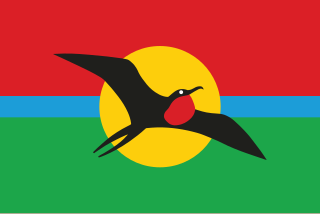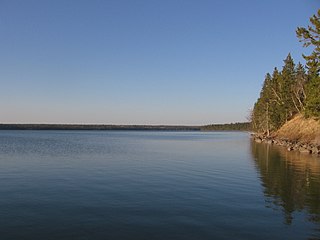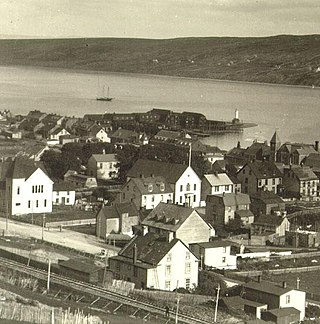| 1870 Census of Manitoba | ||
|---|---|---|
| ||
| General information | ||
| Country | Canada (Province of Manitoba) | |
| Results | ||
| Total population | 12,228 | |
The Census of Manitoba (1870), also known as the Archibald Census, was the first census held in the province of Manitoba, and the overall first census that took place on Canadian territory since the Confederation. The census officially took place on October 27, 1870, based on information collected as of July 16 of the same year, [1] and predates the first nationwide census by five months.
The total population count of Manitoba in 1870 was 12,228.
The 1870 census consisted of one "schedule" or census data collection form with twenty questions including sex, conjugal (marital) condition, religion, age, and birthplace. There were 6,277 males and 5,868 females identified in the census; another 83 Manitobans did not provide a response.
For census purposes, Manitoba was divided into five districts and 33 parishes: [2]
| District | Constituent Parishes | Population |
|---|---|---|
| District I | St. Boniface St. Vital St. Norbert Ste. Agathe Scratching River Near the Line Near Pembina | 2,641 |
| District II | Winnipeg St. John Kildonan St. Paul St. Andrew | 1,523 |
| District III | St. André St. Clément St. Peter Scanderbury | 2,910 |
| District IV | Ste. Anne St. James Headingly St. François Xavier St. Paul St. Charles | 3,271 |
| District V | White Mud Rat Creek Portage Laprairie Westbourne Mission Big Ridge High Bluff Poplar Point Oak Point Lake Manitoban St. Paul-in-Bay Long Lake | 1,883 |
| Manitoba (total) | 12,228 | |
The paper records were microfilmed and are available online at the Library and Archives Canada web site.

Barbuda is an island and dependency located in the eastern Caribbean forming part of the twin-island state of Antigua and Barbuda as an autonomous entity. Barbuda is located approximately 30 miles (48 km) north of Antigua. The only settlements on the island are Codrington and its surrounding localities. Barbuda is a flat island with the western portion being dominated by Codrington Lagoon, and the eastern portion being dominated by the low-lying Barbuda Highlands, with salty ponds and scrubland spread throughout the island. The climate is classified as tropical marine.

Antigua and Barbuda is an island nation made up of: Antigua island, which is divided into six parishes; and of the two dependencies of Barbuda island and Redonda island.

The Queen Elizabeth Islands are the northernmost cluster of islands in Canada's Arctic Archipelago, split between Nunavut and the Northwest Territories in Northern Canada. The Queen Elizabeth Islands contain approximately 14% of the global glacier and ice cap area. The southern islands are called the Parry Islands or Parry Archipelago.
Omidiyeh is a city in the Central District of Omidiyeh County, Khuzestan province, Iran, serving as capital of both the county and the district.

Riding Mountain National Park is a national park in Manitoba, Canada. The park is located within Treaty 2 Territory and sits atop the Manitoba Escarpment. Consisting of a protected area 2,969 km2 (1,146 sq mi), the forested parkland stands in sharp contrast to the surrounding prairie farmland. It was designated a national park because it protects three different ecosystems that converge in the area; grasslands, upland boreal and eastern deciduous forests. It is most easily reached by Highway 10 which passes through the park. The south entrance is at the townsite of Wasagaming, which is the only commercial centre within the park boundaries.

Harbour Grace is a town in Conception Bay on the Avalon Peninsula in the province of Newfoundland and Labrador, Canada. With roots dating back to the 16th century, it is one of the oldest towns in North America.

The 1999 World Junior Ice Hockey Championships was held in Winnipeg, and five other communities in Manitoba, Canada from December 26, 1998, to January 5, 1999. In the gold medal match at Winnipeg Arena, Russia defeated Canada 3–2 on Artem Chubarov's overtime goal. The bronze medal was claimed by Slovakia, giving the six-year-old country its first medal at an IIHF event.
The Calgary Rage are a women's football team in the Western Women's Canadian Football League's (WWCFL) Western Conference. They are based in Calgary, Alberta.

Ashleigh Hewson is a former Australian rugby union player and captain of the Australian national women's team, the Wallaroos. She was a member of the Wallaroos squad at three Rugby World Cups — 2010, 2014 and 2017.
Annaleah Bodle is a former New Zealand rugby union player. She was a member of New Zealand's Champion 1998 and 2002 Rugby World Cup squads.
Windermere High School is a high school in Lake Butler, an unincorporated area located in the southwest portion of Orange County, Florida, USA, within the Orlando metropolitan area. The school is part of the Orange County Public Schools district.

Chris Odom is an American football defensive end for the Houston Roughnecks of the United Football League (UFL). He played college football at Arkansas State. Odom has also been a member of the Atlanta Falcons, Green Bay Packers, Salt Lake Stallions, Washington Redskins, Calgary Stampeders, and Cleveland Browns. With the Houston Gamblers, he led the USFL in sacks and was named its Defensive Player of the Year in 2022.
The 1961 Canadian census was a detailed enumeration of the Canadian population. Census day was June 16, 1961. On that day, Statistics Canada attempted to count every person in Canada. The total population count of Canada was 18,238,247. This was a 13.4% increase over the 1956 census of 16,080,791.
The 1956 Canadian census was a detailed enumeration of the Canadian population. The total population count of Canada was 16,080,791. This was a 14.8% increase over the 1951 census of 14,009,429..
The 1901 Canadian census was a detailed enumeration of the Canadian population. The census was started on June 1, 1901. All reports had been received by February 26, 1902. The total population count of Canada was 5,371,315. This was an increase of 11% over the 1891 census of 4,833,239.
The Census of Canada 1890–91 was a detailed enumeration of the Canadian population. The census took place on April 5, 1891. The total population count of Canada was 4,833,239, an increase of 11.8% over the 1881 census of 4,324,810.
The Census of Canada 1880–81 marked the second regularly scheduled collection of national statistics of the Canadian population. The census took place on April 4, 1881, having been assented to via the Census Act on May 15, 1879. The total population count of Canada was 4,324,810. Dependent on the quoted figure, this is either a 24.1% increase from the 1871 census's 3,485,761, or a 17.2% increase from the 1871 estimate's 3,689,257.
{{cite web}}: CS1 maint: url-status (link){{cite web}}: CS1 maint: url-status (link)